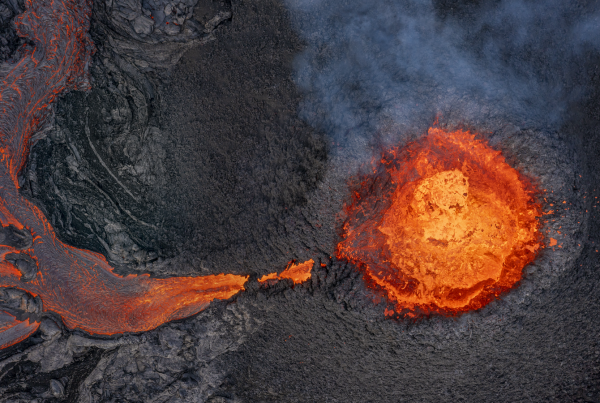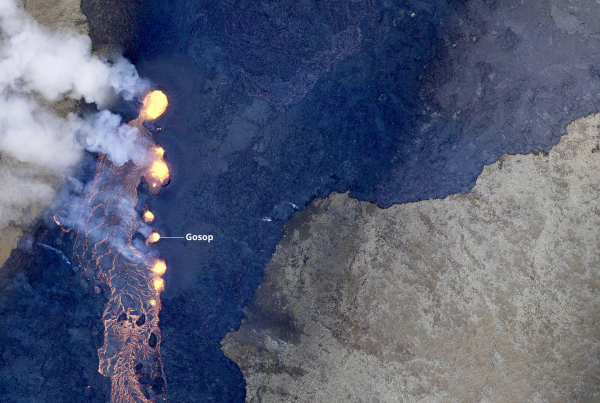
The Blue Lagoon overlooking Mt. Thorbjorn. Photo by Frank Denney on Unsplash
A town hall meeting was called in Grindavik on the Reykjanes peninsula Monday afternoon. The topic of the meeting was the geological development in the area which gives reason to be alert, although it has been stated that there is no emergency and no reason to evacuate or change any travel plans. The development is unusual though and there is therefor a reason to monitor the situation closely and revisit all plans in case it turns into a volcanic eruption. The authorities have therefor declared a state of uncertainty – code yellow. Which means “we are monitoring the development but there is still no reason to take any action”. So before we go any further, let’s look at what has led to this meeting.
Earthquake Swarm

Earthquake swarm around Mt. Thorbjorn and the town of Grindavik. Photo from Lava Centre’s live earthquake monitor
On January 22nd 2020 an earthquake measuring M3.7 shook houses on Reykjanes peninsula, followed by another one of 3.6. This is not unusual given how active the region is. The Reykjanes peninsula has some earthquakes every day although most of those are usually so small that you will not notice them. These two larger earthquakes have been followed by a few hundred smaller earthquakes in the last eight days. The swarm has been continuing in the last days while the land continues to rise at the same rate.
3D model of the Earthquakes on Reykjanes Peninsula during the last 60 days. Colors indicate time where blue are the oldest quakes and red the newest. The size indicates the magnitude. Video by Bæring Gunnar Steinþórsson.
Tectonic Plates

The bridge between continents is on the tectonic rift zone on the Reykjanes peninsula. Photo by Chris73.
The Reykjanes Peninsula and the Reykjanes Geopark are on a tectonic fault line. While you may have heard quite a bit about the San Andreas fault line in California and what that may mean, this fault line is different. In Iceland we have what is called a normal fault line, meaning tectonic plates are moving apart from each other. This means that the movement can generate earthquakes, some of considerable size, but still nowhere near the size of earthquakes created by strike-slip fault lines where one plate moves along another (as in San Andreas) or thrust fault lines where one plate moves directly under another (like the ones causing the 2004 Indian Ocean tsunami and the 2011 Tohoku tsunami in Japan).
Iceland is located on top of (and created by) a mantle plume (volcanic hot spot), similar to Haiwaii and the Galapagos. The movements of the plates have left canyons and rift valleys in Iceland which some are popular tourist spots (such as The Bridge Between Continents and Thingvellir National Park), as well as a network of active volcanoes that dot the country from the SW corner to the NE.
Magma Accumulation

An InSAR measurement (InSAR: interferometric analysis of synthetic aperture radar images) based on satellite information showing the inflation during the period from Jan 18-24. The red colour indicates an inflation of around 15mm during the period. (Vincent Drouin, ISOR).
What makes this earthquake swarm unusual and gives reasons to a heightened alert is the inflation that has accompanied it.
Just west of Mt. Thorbjörn, a couple of kilometers to the west of the epicenter of the earthquakes, land has been rising 3-4mm per day and has now passed 3 cm total in the last 7 days. This can mean that magma is moving underneath the surface and accumulating in this location. In such situations there is always the potential of moving magma finding a way out – leading to an eruption.
This is the reason nearby citizens were called to a meeting discussing this potential and how to react to it. While an eruption is still an unlikely outcome, scientists are monitoring the area closely and everyone will be prepared for the worst case scenario. A little further east is a place called Hrútagjárdyngja, where magma accumulation resulted in a 30 meter inflation – without the magma ever reaching the surface. That is about 1.000 times more than what we have now seen west of Mt. Thorbjörn.
This is why an eruption is still considered an unlikely result but due to the proximity to human habitation, all precaution is taken.
Last eruption in 1240
The Reykjanes peninsula is a highly active volcanic area. Hence the Svartsengi geothermal plant where the Blue Lagoon gets it’s energy and hot water from, and the hot springs you find in many places in the region. It is important though to understand what highly active means in geological terms. The last eruption was in the year 1240. There will be another eruption soon as they happen on average every 700-1000 years in this region, but if it will be this century or the next or even the one after that is hard to say. Soon in geological terms might be days or decades away.
How far is this from the Blue Lagoon, the airport and Reykjavik?
The location of the activities is only a few kilometers east of the legendary geothermal spa The Blue Lagoon. That means the epicenter is about 40 minutes drive from Reykjavik and about 20 minutes drive from Keflavik airport. To the south of the epicenter is the town of Grindavík with 3.500 inhabitants. There is still no reason to change any travel plans to the Blue Lagoon, to Keflavik airport, the town of Grindavik nor to the capital Reykjavik. If an eruption starts it will still give plenty of time to evacuate the premises. The Blue Lagoon has two routes away from the facilities leading in opposite directions and the town of Grindavik has three routes plus a harbor. So if the road closes there are always alternative routes.
What can we expect?
The Icelandic MET Office is closely monitoring the development and has been setting up more GPS trackers, seismometers and other tools to increase the accuracy of the data. Activities of this type are very common in Iceland and while they are usually found in the events leading up to a volcanic eruption, they most often lead to nothing more than this. Land inflation and an earthquake swarm. Meaning that there is rarely a volcanic eruption without this being part of the process, but that this process happens most often without leading to a volcanic eruption.
There are two likely causes to this development. The first one is magma accumulation and the second one is tectonic tension. Here is an evaluation of both causes from the geologists at the Icelandic MET Office and the possible scenarios that may play out:
“The activity has only been ongoing for a few days and it is uncertain if it will escalate to more serious activity. Based on current information, the following scenarios are considered possible, without stating which is most likely or within what time-frame.
-
If the inflation is due to magma accumulation:
- Magma accumulation will cease soon without further activity.
- Magma accumulation continues for some time without further activity.
- Magma accumulation will lead to a magma intrusion.
- Magma accumulation will lead to magma intrusion and eruption (effusive fissure eruption).
- Magma accumulation triggers seismic activity with larger earthquakes (up to M6.0).
-
If the inflation is not caused by magma accumulation:
- The inflation might be linked to tectonic activity and lead to larger earthquakes (up to M6.0).”
How should I prepare?
- Like always when travelling in Iceland, it is good to check the local news, check the local weather forecasts every evening and morning and see if there are any travel warnings. Please use the local information not the one you use at home or the iPhone recommended app. We recommend the following websites: The Icelandic Met Office – vedur.is, SafeTravel.is and the The Icelandic Road and Coastal Administration – road.is. You can set up phone notifications for twitter accounts like @safeiniceland, @vegagerdin and @vedurstofan but sadly they are not very active. If you are staying at a hotel you can talk to the front desk and ask them to help you find other information you might need. On LavaCentre.is you can find live updates on earthquakes in all of Iceland and the twitter and instagram accounts are very active during episodes like these .
- Do not hike in the area of the epicenter.
- Other than that, just travel as normal and enjoy the view of raw landscape in constant formation.
In the next two posts we look at two different scenarios at Thorbjörn fell. First what impact it may have if this actually leads to a volcanic eruption and secondly what can happen if this leads to a bigger earthquake.



